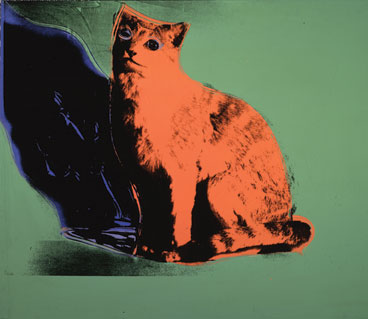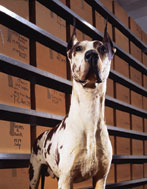|
 |

Andy Warhol, Cat, 1976. The Andy Warhol Museum, Pittsburgh;
Founding Collection, Contribution The Andy Warhol Foundation for the Visual Arts, Inc.
Animal Attraction
Andy Warhol’s affection for animals inspired his famous Endangered Species series, and pets of all kinds—from his childhood mutt, Lucy, to a taxidermy peacock—impacted his life and were elevated as subjects of his art. So it’s only fitting that it was his Factory watchdog, Cecil, who roused The Andy Warhol Museum’s latest exhibition, Canis Major: Warhol’s Dogs and Cats (and Other Party Animals).
By Justin Hopper
Since The Andy Warhol Museum opened nearly 15 years ago, Cecil has been there, diligently standing guard over the coatroom. It’s a position he knows well. Throughout the 1970s and 1980s, the stuffed Great Dane acted as a guard dog, mascot, and cigar-store Indian for Warhol’s Factory studio in New York City. He appeared in photos with Warhol’s superstars and in Warhol’s series of dog paintings.
While Cecil’s loyalty might never have been questioned, his origins were a different story. He arrived at The Warhol prior to its opening with nothing but an apocryphal tale from the artist’s colleagues, according to The Warhol’s archivist, Matt Wrbican. Seems Warhol had heard from friends that an antiques dealer had a stuffed dog that once belonged to filmmaker Cecil B. De Mille, legendary movie director of The Ten Commandments fame (hence the name), and quickly acquired the dog.
 That was the whole story—until now. With the help of Ohio-based canine photographer and breeding enthusiast Kerrin Winter-Churchill, and a little bit of serendipity, Cecil’s story has finally come to light, providing the impetus for Canis Major: Warhol’s Dogs and Cats (and Other Party Animals), a new exhibition of Warhol’s animal art on view at The Warhol through May 4, 2008. That was the whole story—until now. With the help of Ohio-based canine photographer and breeding enthusiast Kerrin Winter-Churchill, and a little bit of serendipity, Cecil’s story has finally come to light, providing the impetus for Canis Major: Warhol’s Dogs and Cats (and Other Party Animals), a new exhibition of Warhol’s animal art on view at The Warhol through May 4, 2008.
“I knew that Cecil was a really beautiful specimen,” says Wrbican, under whose auspices the dog falls, and who curated Canis Major, “both as a dog and as a remarkable example of taxidermy. He needed repairs just before we opened, and the taxidermist at Carnegie Museum of Natural History told me, ‘You need to find out who did this—it’s one of the best examples of taxidermy I’ve ever seen.’”
Last year, Wrbican received a phone call from Winter-Churchill, who had recently visited The Warhol and, thanks to some rather specialized knowledge, made an odd discovery.
“She just said, ‘I know who your dog is,’” recalls Wrbican. “Thing is, I don’t even have a dog—I’m a cat person.” But it was Cecil she meant, whom Winter-Churchill had recognized immediately from research she’d done using old issues of the American Kennel Club’s Gazette.
It turns out “Cecil” is actually Ador Tipp Topp, a German-bred champion dog who won the prestigious Westminster Kennel Club Dog Show in the 1920s. Winter-Churchill went on to research Ador’s post-mortem history and discovered that, after Ador’s demise in 1930, he was given to a taxidermist for a collection of dog-breed specimens at Yale University’s Peabody Museum. There he languished, first on display and later in storage, for more than three decades.
“One day in the ’60s, a drama student at Yale was sent to the Peabody Museum to get a stuffed bird for a production,” says Wrbican. “They told him, ‘We don’t have any birds, but I’ll sell you dogs for ten bucks each.’”
Ador passed through the hands of the drama student, a Manhattan poet named ‘Barefoot,’ and onto the antiques dealer—somewhere along the line acquiring the Cecil B. De Mille story and, through Warhol’s ownership, actual fame-by-association.
As part of Canis Major, which includes drawings by Warhol’s mother, Julia Warhol, as well as drawings, photographs, and video by Warhol, Ador’s original pedigree will be on display—his American Kennel Club papers and German family tree—thanks to Winter-Churchill’s research. But Ador’s story, and Canis Major, also brings to light a side of Andy Warhol that may not be as well known as other parts of his work and life. Paintings from Warhol’s Dogs & Cats series, and films and photographs of the artist’s colleagues, such as Robert Indiana and Jean-Michel Basquiat with their pets, show a more domestic side to Warhol.
“In many ways, he was a very normal person,” says Wrbican. “We’ve included things like his pet dachshund Archie’s vaccination papers and sweaters, and a box of treats that were sent to Archie from Baltimore Museum of Art curator Brenda Richardson.”
Of the color-splashed, silk-screen-styled paintings of animals on display, three in particular stand out and are located separately in The Warhol’s basement level. These animals—a cat, Patience; a terrier mix, Peggy Sue; and Evelyn, a rabbit—are all still alive today, right here in Pittsburgh.
As a joint venture with local shelter Animal Friends, The Warhol’s education department borrowed three pets waiting for adoption and gave them their “15 Minutes of Fame”—silkscreen portraits of the animals, painted in Warhol’s style, added to the rest of the Canis Major exhibit, as well as films of other shelter animals in the tradition of Warhol’s Screen Tests.
“Animal Friends chose a cat, a dog, and a bunny waiting for adoption, and we did the paintings,” says Tresa Varner, The Warhol’s curator of education and interpretation. “Then, in our workshops with elementary, middle, and high school students, we’ll have the kids come in and look at Warhol’s work, do silkscreens of these animals, and Animal Friends will teach bite prevention and humane practices.”
It’s a plan that Varner hopes will continue long after Canis Major wraps up, and one she thinks Warhol would’ve appreciated.
“Warhol’s Endangered Species series was a kind of campaign to raise awareness about the importance of the topic,” says Varner. “I think these were issues he was always interested in.”
|
 Spring 2008
Spring 2008


 That was the whole story—until now. With the help of Ohio-based canine photographer and breeding enthusiast Kerrin Winter-Churchill, and a little bit of serendipity, Cecil’s story has finally come to light, providing the impetus for Canis Major: Warhol’s Dogs and Cats (and Other Party Animals), a new exhibition of Warhol’s animal art on view at The Warhol through May 4, 2008.
That was the whole story—until now. With the help of Ohio-based canine photographer and breeding enthusiast Kerrin Winter-Churchill, and a little bit of serendipity, Cecil’s story has finally come to light, providing the impetus for Canis Major: Warhol’s Dogs and Cats (and Other Party Animals), a new exhibition of Warhol’s animal art on view at The Warhol through May 4, 2008.